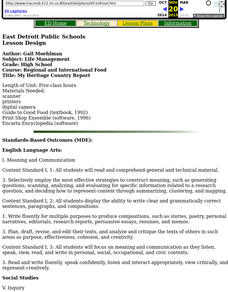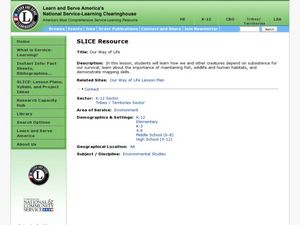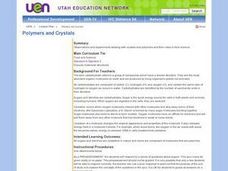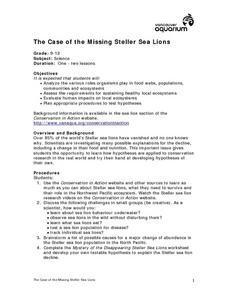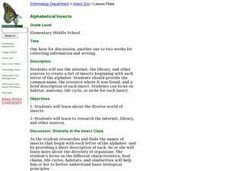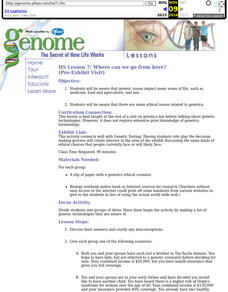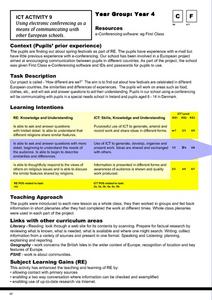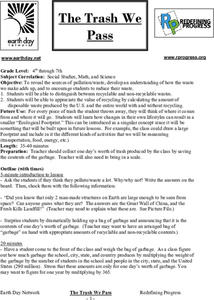Curated OER
Which Wrap Is Wrapped Right?
Young scholars investigate the integrity and strength of different types of food wraps. They test the wraps and create a graphic organizer for the data. Once it is organized then a lab report can be written. The lesson plan contains...
Curated OER
AT YOUR FINGERTIPS
The student will locate countries on a world map from which we import foods that our climate prevents us from growing locally.1. Discuss the term "export." Divide middle schoolers into groups of four. Give the groups
five minutes to...
Curated OER
Science: Let's Be Molecules!
Students discover how molecules are in constant motion. Through a simple experiment of water containing food coloring, they observe the drops of coloring move even though the water is still. Role-playing as molecules, students stand up...
Curated OER
Build a Burger
Pupils read about hamburgers and analyze a healthy diet as well as the importance of nutrition. In this nutrition education activity, students read the background information about hamburgers and their nutrition facts. Pupils complete...
Curated OER
Grinding corn in Swaziland
Learners participate in grinding corn, a major part of food preparation in rural Swaziland.
Curated OER
My Heritage Country Report
Students list five food dishes that are part of their family's heritage. Each student then does research of a country and a recipe (possibly a family recipe). With the help of members of his/her kitchen group, the student prepares the dish.
Curated OER
Our Way of Life
Students interview Native American Elders about animal migration, traditional food gathering, and subsistence. They research endangered animals, draw a game cycle, and create maps of local migration of animals.
Curated OER
Polymers and Crystals
Learners experiment with crystals and polymers and examine their roles in food science.
Curated OER
Hatching Chicks to Agriculture - Where does the feed come from?
Second graders examine the types of grain that goes into feed for chickens. They study other grain crops grown in Kansas and the foods that are made from them.
Curated OER
Ancient Recipes
Young scholars explore how foods and their preparation differ over time and from culture to culture. An ancient recipe for the preparation of goat, found by archaeologists, is examined and discussed by the students.
Curated OER
How Much Radiation is Around You?
Middle schoolers examine the use, misuse and fear of radiation. They read an article about radiation on food and discuss the positives and negatives of this process. They answer questions to complete the lesson.
Curated OER
The Case of the Missing Steller Sea Lions
Students identify and analyze the various roles organisms play in food webs, populations, communities and ecosystems. Students assess the requirements for sustaining healthy local ecosystems. STudents evaluate human impacts on local...
Curated OER
Endangered Spaces = Endangered Species!
Sixth graders discuss the crowding, loss of personal space, loss of home, loss of food, etc. that might occur at a developmental site. They witness, through an in-class demonstration, what happens when land is taken for development. They...
Curated OER
Alphabetical Insects
Students research using the internet, the library, and other sources to create a list of insects beginning with each letter of the alphabet. They provide the common name, the resource where it was found, and a brief description of each...
Curated OER
The Little Orange Rooster
Third graders brainstorm a list of heat sources they are aware of. After listening to a story, they identify the different types of machines mentioned and sort them based on whether they run on gasoline or electricity. To end the...
Curated OER
Genome: The Secret of How Life Works
Young scholars become aware that genetic issues impact many areas of life, such as medicine, food and agriculture, and law. They become aware that there are many ethical issues related to genetics.
Curated OER
Honey ! I Blew Up The Bee!
Second graders complete a variety of bee-themed activities. They consider the importance of honeybees in food production, conduct Internet research, prepare foods using honey, complete puzzles and compile a portfolio of their work.
Curated OER
Ohlone Indians
Fourth graders use various pictures to identify the economic activities, food supply or religious beliefs of the Ohlone Indians. Students create a cooperative learning travel brochure.
Curated OER
Sea Ice Research
Learners study sea ice and its importance in climate and climate change. They discuss sea ice as a presence of a food source for marine animals in the arctic and complete a lab activity. After completing the lab, they watch a video...
Curated OER
Ict Activity 9
Fourth graders experience and study electronic conferencing as a means of communicating with other European schools. They assess various ways of communicating with other students to compare similarities and differences between...
Curated OER
Outdoor Art
Students create art projects outside. In these outdoor art lesson plans, students use items in nature to enhance their creativity. They are encouraged to paint rocks, use fences for collages, weave sticks/feathers through picket fences,...
Curated OER
Which Has The Most?
Learners are part of a class poll where they choose their favorite food and their favorite toy. In this which has the most lesson, students are given a block to represent their choice. Learners then place the block by the picture of...
Curated OER
Florida Springs
Students discover the many uses of water and the sources of the water we see. They complete a worksheet about the water usage at school and at home.
Curated OER
THe Trash We Pass
Students identify the sources of pollution and waste in their community. They examine the process of recycling and how to eliminate some of their family waste.
Other popular searches
- Food Sources
- Food Origins
- Aboriginal Food Sources
- Esl Food Sources
- Food Origins Of
- Science Sources of Food







